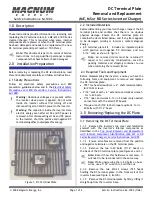
D i g i g r a m
12
APPENDIX A: GPIO CONNECTORS
ES881v2, ES1241v2, and ES161
four relay GPOs.
GPIs allow sending commands to th
GPOs can be
used by the EtherSound configuration so
vices.
The GPIO p
abel
General Purpose Inputs (
show the particular design for each GPI. The GPI status can be either “1” or “0”. It is read
stem connected to the GPI creates the current lab led “i” on the scheme. Otherwise it is
erent GPI designs allow for multiple ways to e
offering utmost flexibility
figuration to best meet your needs.
g +5 V electric
d pin 4 being
ground may
the
of other GPIs.
GPI #1 uses pins 1 & 2
current flow for GPI #3 and GPI #4.
tate to 0:
Pin 1 is to be
ically by
connecting it to
GPI #3 uses pins 1 & 4
Switching the GPI state to
Pin 3 is to be connected to ground to establish the “i” current, typically by
& GPI #4
GPI #3 uses pins 5 & 6, GP
.
Switching the GPI state to 0:
A current flow
r from pin 8 to
pin 7 (GPI #4)
GPI optocoupler specif
61v2 feature four optocoupled GPIs and
e EtherSound configuration software,
ftware for remote control of external de
ins are l
ed 1 through 8 on the rear panel as illustrated.
GPIs)
Schematic diagrams
“0” as soon as the sy
read “1”. Diff
in system con
e
stablish this current, thus
Note: Pin 2 deliverin
configuration
GPI #1
potential an
connected to
also be used in
Pin 2 de5 V electric potential. This pin may serve as a source to create a
Switching the GPI s
connected to ground to establish the “i
”
current, typ
pin 4.
GPI #1
0:
connecting it to pin 4.
GPI #3
I #4 uses pins 7 & 8
is to be established from pin 6 to pin 5 (GPI #3) o
.
ications














































